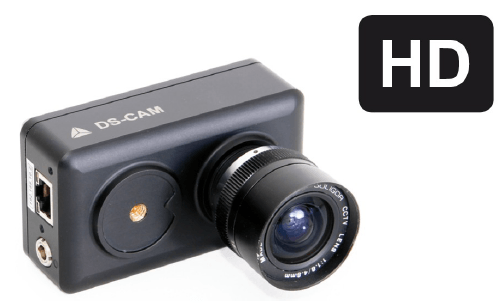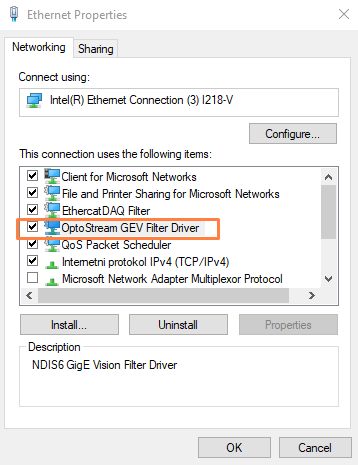Usually, the camera is operated in the Start on Dewesoft trigger mode, using a Dewesoft Counter input for the highest precision.
System requirements
- Dewesoft measurement instrument
- PHOTRON highspeed camera (e.g. FASTCAM Mini UX100, 10 000 fps @ 896 x 488)
- 1 free Ethernet port on the computer
- 1 Dewesoft Counter input
- an additional light source
The example below shows a PHOTRON camera (connected over Ethernet) and a DEWE-43 (connected over USB to the notebook). The accelerometer (blue cable) is used to measure the hit of the fingertip, this is also the trigger. The camera puts out a start pulse on the TRIG_TTL_OUT port, which is measured back on one of the Counter inputs of the DEWE-43.
In the photo below, you can see the high-speed camera with the Dewesoft data acquisition instrument (DEWE-43).
 Image 80: High-speed camera setup
Image 80: High-speed camera setup
DEWE-43 to PHOTRON connection in detail:
 Image 81: Photron camera connection detail
Image 81: Photron camera connection detail
System preparation
Windows network configuration
Please enter the Control Panel, go to the Network Connections and right-click on the Port, where your Photron camera is connected to. Go to Properties and select the TCP/IPv4 protocol. Depending on the model the default IP address is usually:
- camera IP: 192.168.0.10 / set computer to 192.168.0.XXX. If a connection cannot be established, please try:
- camera IP: 192.168.10.0 / set computer to 192.168.10.XXX
The subnet is always 255.255.255.0. This is the default for the currently available cameras. Please refer to the Photron camera manual for further information about the default IP address. Please enter
 Image 82: Network connection settings
Image 82: Network connection settings
Camera IP reset (factory default)
In case you have troubles connecting to the camera, you can try to set it to factory default by the following routine:
- Press and hold the RESET switch at the camera's backside.
- All of the LEDs on the camera's back sidelight, then they turn off sequentially from right to left. In the end, all LEDs together blink twice, then stay on. This takes several seconds, hold the button pressed all the time.
- Then reboot the camera. The IP address is reset to the factory setting.
Photron FASTCAM Viewer
For checking the network connection (and changing the camera settings), you can use the previously installed Photron FASTCAM Viewer to get a live picture. Please enter the IP address mask as shown above, then click Detect, an auto-search will be performed. Alternatively, click File / Camera open.
 Image 83: Photron Fastcam Viewer
Image 83: Photron Fastcam Viewer
Camera TRIG_TTL_OUT pulse duration
When using the Start on Dewesoft trigger option inside Dewesoft, Dewesoft does the synchronization based on the first frame captured by the camera. In the Photron FASTCAM Viewer, please go to Camera Option and increase the pulse output time from 100 nsec (default) to 100 usec, in order to guarantee a proper triggering under any circumstances.
 Image 84: TRIG_TTL_OUT setup in PFV
Image 84: TRIG_TTL_OUT setup in PFV
Setup in Dewesoft
Photron.ini file
During installation, we have copied Photron.ini into the Dewesoft X Addons folder (e.g. C:\DewesoftX\X3\Addons64\). This file contains the interface type and IP address of the camera, please set it accordingly.
 Image 85: Photron.ini file
Image 85: Photron.ini file
Enabling the camera
In Dewesoft X go to Settings / Settings / Devices, click the add button and add the Photron FastCam.
 Image 86: Enable the camera in Dewesoft
Image 86: Enable the camera in Dewesoft
The Photron FastCam camera is successfully found.
 Image 87: Camera successfully found
Image 87: Camera successfully found
When you click on the camera, you should be able to see the model and it's IP address.
Trigger setup
There are three different types of camera trigger:
 Image 88: Store trigger options
Image 88: Store trigger options
Store on Dewesoft trigger
 Image 89: Store on Dewesoft trigger
Image 89: Store on Dewesoft trigger
This is the most commonly used wiring. The software triggers even on complex trigger conditions on analog input, and sends the start impulse over Ethernet. The camera sends a pulse, when the first frame is recorded, this is measured back with the very accurate Dewesoft super-counters (102 MHz timebase) for synchronization.
Store on external trigger
 Image 90: Store on an external trigger
Image 90: Store on an external trigger
If the camera is triggered with an external trigger, then the same signal can also be used for synchronization.
Store on start of acquisition
The camera will start with the beginning of data recording (streaming). This is of less practical usage, because depending on the framerate, measurement duration and camera onboard memory, the acquisition time is limited.
Store on Dewesoft trigger - example
For connection example, we want to acquire both analog and video data of a hit of an accelerometer with the fingertip.
The analog input sampling rate we set to 200 kS/s (this does not affect the 102 MHz counter sampling rate).
 Image 91: Set the analog input channel on used
Image 91: Set the analog input channel on used
We enter the channel setup to get a preview of the signal and check the appropriate trigger level. In the picture below, there is an example of a signal when knocking with a finger on the sensor.
 Image 92: Preview the signal in channel settings
Image 92: Preview the signal in channel settings
If the Counter section is not visible in the first place, please add them with the plus button from the top. The Counter is set to Event Counting, Basic Event Counting by default, which is ok. Please enable the button on the left of e.g. CNT2/IN0.
 Image 95: Counters
Image 95: Counters
The trigger setup looks like shown below. We select fast on trigger, rising edge with a level of 1g. The pre-time is 100ms, post time 500ms. Dewesoft supports complex trigger conditions, such as simple edge, filtered edge, window, pulse width, slope, delta amplitude, as well as any logical combination on any analog / digital / math channel.
 Image 94: Set storing type on fast on trigger
Image 94: Set storing type on fast on trigger
Camera setup
In the video setup, you can see all available cameras. Set the camera to Used, then enter the Setup.
The screen on the next page shows the Trigger setup and the Camera settings, as well as a live preview for adjusting the setup (focus, light source, etc).
Here you can set Resolution, Frame rate, Shutter speed and Sensor gain (if the camera supports hardware sensor gain) parameters. You can also calibrate the camera sensor here. The options depend on the camera model in use and also from each other. For example, if you increase the frame rate, the shutter time will be limited.
The camera settings are applied to the camera as soon as something is changed, so the preview is always up to date with current settings.
 Image 95: Camera setup
Image 95: Camera setup
Please select the Counter and adjust the level to 0.5, as this is a digital channel (0 to 1). When the camera is started over Ethernet, depending on system load and operating system there will be a delay to the storing trigger. This is usually around 50...100ms (in the example below around 70ms, red line). Therefore, we have to set the camera buffer a little bit higher to capture the whole time window.
 Image 96: Trigger explanation
Image 96: Trigger explanation
Camera sensor calibration
Each camera comes with two sensor calibration files. Here is an example of how the calibration files are named (e.g. for FastCam 1024 PCI):
- PixelGainData_Default_1024PCI_1455_0009_0164.gdf
- shadingdata_1024pci_1455_0009_0164.gdf
If you copy these files from the Photron CD to Dewesoft Addons folder, they will be used automatically. Files are optimized for 1000 fps frame rate and picture will not be optimal when other frame rates are selected. If you do not have these files or factory calibration data is not satisfying or for any other reason the picture is grainy and/or contains fixed shading pattern, you have to calibrate the sensor to get a better picture. You can do that by selecting Calibrate camera sensor from Custom setup and press the Set button. The Calibrate camera window will pop up. Just follow the instructions (Close camera lens and then press OK) and the sensor will get calibrated.
 Image 97: Camera calibration
Image 97: Camera calibration
In the picture below, there is a picture from the camera before (left) and after (right) calibration.
 Image 98: Right picture shows better visibility after calibration in comparison to the first one
Image 98: Right picture shows better visibility after calibration in comparison to the first one
Video download
After the measurement, Dewesoft will show the whole recorded video data. You can navigate without noticeable delay, however, it is only accessing the camera onboard memory. If you have verified the data to be good, you can finally download the video file to the computer. This can take from minutes to hours, depending on the file size.
Example data file
The example below shows the explosion of the firecracker.
 Image 99: Image shows the explosion of the firecracker
Image 99: Image shows the explosion of the firecracker
Frequently asked questions
Camera not detected in PFV
Camera model type not checked in PFV device list:
 Image 100: PDV
Image 100: PDV
In Photron FASTCAM Viewer, go to Configuration and select all camera models from the Device List. Now it will search for all of them.
Try connecting multiple times
Sometimes when connecting with PFV, the camera is not found in the first place. Please try again several times.
Network troubles
Disable Windows firewall, disable anti-virus, check IP, reset the camera to factory defaults.





























































































